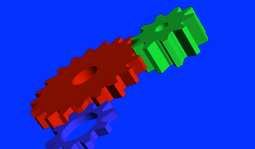Display hardware-rendered content using OpenGL ES 2.x
Syntax:
gles2-gears [-config=egl_configuration] [-display=egl_display_id] [-interval=swap_interval] [-size=widthxheight] [-verbose]
Runs on:
QNX Neutrino
Options:
- -config=egl_configuration
-
Set optional EGL configuration specfiers. These optional configuration specifiers are set using a comma-separated list. The specifiers may include the following: pixel format and/or multi-sampling specifications, or an EGL configuration number. If you're using an EGL configuration number, it must not be specified with other specifiers.
- Pixel format
-
Specify pixel format as one of the following:
- rgba8888 or rgbx8888
- rgba5551 or rgbx5551
- rgb565
- rgba4444 or rgbx4444
where "a" indicates alpha bits and "x" indicates ignored bits.
- Sampling
-
Specify multi-sampling as:
[rate]x
where rate is a valid sampling rate (e.g., 2, 4, 8, ...).
- EGL configuration number
- Specify as an integer. The integer must be a valid EGL configuration ID (EGL_CONFIG_ID).
For example, the following are all valid ways of specifying the EGL configuation option:
- -config=rgb565
- -config=rgba8888,4x
- -config=12
If no specific EGL configuration is provided, this utility gets the RGB pixel format with the smallest bit depth supported by the hardware.
- -display=egl_display_id
-
Set the display, as an integer to show content. Use the EGL display ID that's been configured in the khronos section of your configuation file, graphics.conf.
If no EGL display ID is provided, then this utility uses the default display.
- -interval=swap_interval
- Set the swap interval (default is 1). The swap interval is the minimum number of vsync periods between image updates.
- -size=widthxheight
- Set the size, using integer values for width and height, of the viewport (default is fullscreen).
- -verbose
- Print information to display.
Description:
The gles2-gears binary is a command-line tool that can be used to confirm that screen is running, and that all necessary drivers for OpenGL ES 2.x are in place, and can start successfully.
To run gles2-gears:
- Ensure that screen is running.
- Run gles2-gears from a shell.
Examples:
# gles2-gears
